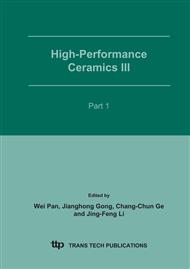p.631
p.635
p.639
p.643
p.647
p.651
p.655
p.657
p.661
Photocatalytic Properties of the Transition Metal Doped TiO2 Powder Prepared by Sol-Gel Process
Abstract:
Transition metal-doped TiO2 powders as a photocatalyst were prepared by sol-gel process and Sb, Bi and Nb were introduced into them as dopants. The photocatalytic behaviors of the doped TiO2 powder were studied as a function of dopant, doping concentration and preparation conditions. X-ray diffraction, FT-Raman, B.E.T. and scanning electron microscopy were applied for structural and microstructural studies. Optical properties of the doped TiO2 powders were studied by UV-Visible Spectrometer and photocatalytic activity of the doped TiO2 was characterized in terms of the degradation of 1,4-dichlorobenzene. X-ray difraction analysis showed that doping with a transition metal ion suppresses anatase-to-rutile phase transition compared with the pure TiO2. The Sb and Nb-doped TiO2 powders did not exhibit any other diffraction peaks except those belonging to TiO2. On the other hand, a diffraction peak of Bi4Ti3O12 appears for 5 at.% Bi-doped samples. All of the doped TiO2 powders had higher specific surface area than undoped TiO2. Surface area increased with increasing dopant concentration depending on the dopant, from 33.9 m2/g to 55.4m2/g. The UV-visible absorption spectra of doped samples were red-shifted by 20~50nm according to the doping level. Also transition metal doped TiO2 powders exhibited better photocatalytic activity than the undoped TiO2. The increase in photoactivity is probably due to the increase in the interfacial electron transfer, red shifts, and better crystallinity.
Info:
Periodical:
Pages:
647-650
Citation:
Online since:
February 2007
Authors:
Keywords:
Price:
Сopyright:
© 2005 Trans Tech Publications Ltd. All Rights Reserved
Share:
Citation:


